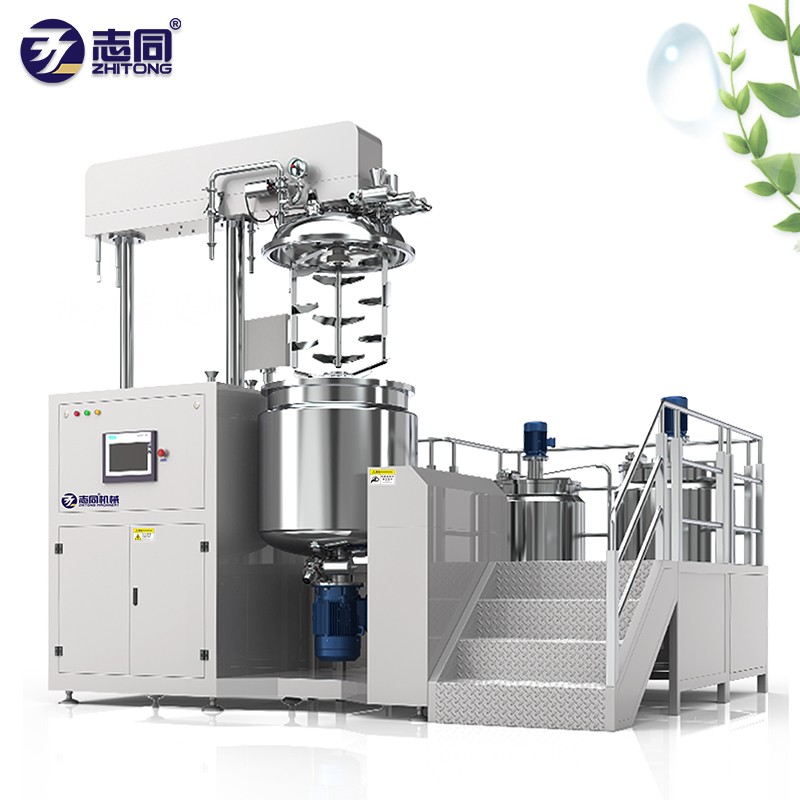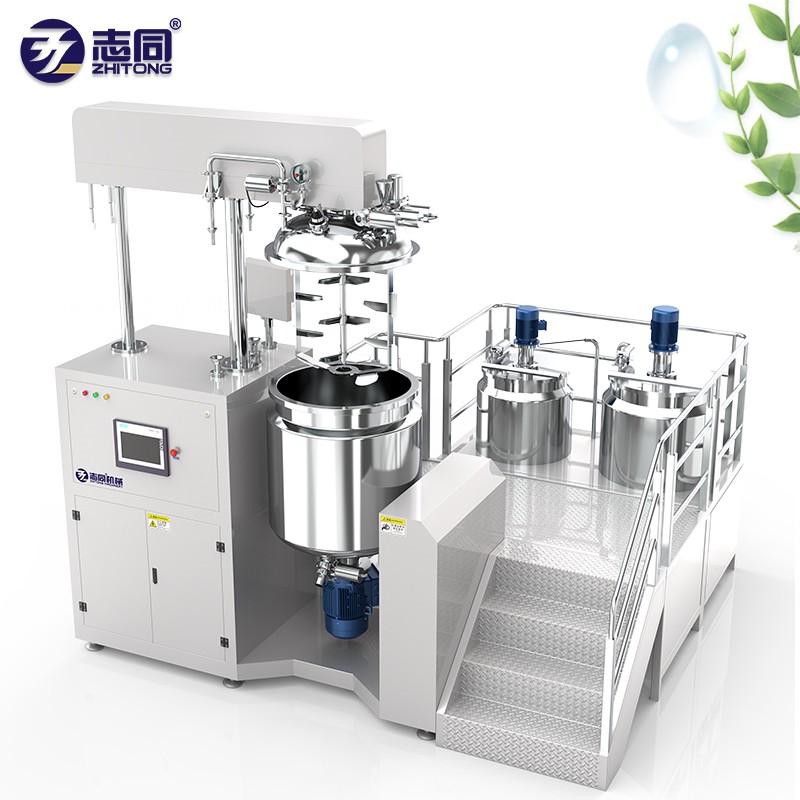We are global supplier for cosmetics, food and pharmaceutical production line machines over 20 years. Especially for mixer’s making, there is own rich making experiences, advanced technology already with factory located in Jiangsu province.
For mixer’s making, it can be customized based on demand. As machine is optional vacuum, mixing, heating, homogenizer go for emulsion, etc function. So machine will be made based on product’s specific making process.
We use cookies to improve your experience. By continuing to browse this site, you agree to our use of cookies. More information.
According to the second law of thermodynamics, most skin care products are unstable in nature because these products are a combination of two or more substances that do not mix with each other. To ensure shelf life, these products must be supplemented with appropriate stabilizers. Typically, ionic or nonionic surfactants are added as emulsifiers.
It is believed that such low molecular weight amphiphiles make cosmetics incompatible with the skin. Therefore, the cosmetics industry is looking for surfactant-free lotions that can replace traditional formulations. To produce sufficiently stable and aesthetically pleasing products, the most promising alternatives include polymer emulsifiers or solid particles as stabilizers.
In addition to using conventional formulation methods, emulsions can be stabilized by using suitable macromolecules instead of low molecular weight surfactants. Emulsion stability is often improved by adding polymers to thicken and increase the yield of the continuous phase.
However, to improve performance, surfactant polymers such as hydroxypropyl methylcellulose or carbomer 1342 can be used as the primary emulsifier. These polymers form structured interfacial films that successfully prevent oil droplet coalescence. In this case, the stabilizing effect of increasing the viscosity of the external phase is insignificant.
Such formulation concepts are often referred to as hydrolipid dispersions or aqueous dispersive gels, which are more suitable for sunscreen products and are therefore known as “emulsifier-free” formulations. From a physical and chemical point of view this is incorrect. (According to the International Union of Pure and Applied Chemistry, the properties of an emulsifier are defined as follows: An emulsifier is a surfactant. It reduces the interfacial tension of the solvent medium and therefore has a positive effect on adsorption at A small amount of emulsifier can promote the formation of emulsions or increase their colloidal stability by reducing one or both of the aggregation and coalescence rates.)
What distinguishes these formulations from emulsions stabilized by “traditional” emulsifiers is their ability to cause irritation: polymer emulsifiers have a high molecular weight and therefore cannot penetrate the stratum corneum. Therefore, adverse interactions such as Majorca Acne are not expected. That’s why they are called “emulsifier-free”. Table 1 shows some classic examples.
An acrylate/C10-30 alkyl acrylate crosspolymer was used as the polymer emulsifier in Formula A. Hydroxypropyl methylcellulose and polyacrylic acid were used as co-stabilizers. The acrylic copolymer is a polymer emulsifier carbomer 1342 modified with a C10-30 alkyl acrylate and cross-linked with allyl pentaerythritol.
The lipophilic alkyl acrylate moiety is dominated by the hydrophilic acrylic acid moiety. The resulting macromolecule has a molecular weight of 4 x 109. The material does not dissolve, but when neutralized with a suitable base it expands up to 1000 times.
Carbomer polymer emulsifiers form a thick protective gel layer around each drop of oil in a low electrolyte concentration aqueous phase, with hydrophobic alkyl chains anchored in the oil phase. Standard dosages of polymer emulsifiers of only 0.1% to 0.3% are required to emulsify up to 20% of the oil.
If the lotion comes into contact with an electrolyte-containing skin surface, it becomes unstable because the protective gel layer immediately swells. After removing the oil phase, a thin film of oil remains on the skin. This process makes it easy to create sunscreen products that, despite their hydrophilic properties, are water resistant during use.
Emulsions stabilized by acrylate/C10-30 alkyl acrylate cross-polymers can be prepared by direct or indirect methods (see Table 2).
Table 2 Scheme for the preparation of water-dispersed gels using polymer emulsifiers indirectly or directly
To prevent mechanical degradation of high molecular weight polymer emulsifiers, high-throughput homogenizers should be used with caution as this may reduce emulsion stability. Typically, the average droplet diameter of such compositions is 20–50 μm. But this does not have a negative effect on the stability of the body.
If finely dispersed systems (1-5 microns) are chosen for aesthetic purposes, it is recommended to add an amphiphilic co-emulsifier, for example sorbitan monooleate. However, such formulas can never be called “emulsifier-free.”
Although Formulation B (see bottom of Table 1) is also a hydrolipid dispersion type, it uses only hydroxypropyl methylcellulose (HPMC) as the polymer emulsifier.
Compositions that use HPMC as a polymer emulsifier are less reactive with respect to electrolytes compared to water-lipid dispersions that use the polymer emulsifier carbomer 1342. Thus, oil/water emulsions in which the external phase saline solution is used and remain stable during storage.
Due to mechanical stress when applied to the skin, the lotion may be partially destroyed and form a thin oily film on the skin, which minimizes skin hydration. After the water evaporates, part of the lotion remains on the skin, forming a flexible film in which oil droplets are fixed in a polymer matrix.
HPMC-stabilized emulsions are prepared using a rotor-stator homogenizer such as the Ultra Turrax®. The homogenizer produces small droplets of 2–5 µm in size. High energy input from ultrasonic or high pressure homogenization can be used to produce nanoemulsions with an average diameter of 100-500 nm.
Nanoemulsions stabilized by HPMC can be cold processed from the liquid lipid phase. To obtain the crude pre-emulsion, the liquid oil phase and the aqueous polymer solution were combined at room temperature. The pre-emulsion is passed through a high-pressure homogenizer at 20-90 MPa several times to obtain the final nanoemulsion.
Although it is technically possible to further increase the pressure beyond the optimal range without any problems, this usually results in larger droplet sizes and does not achieve the desired higher dispersion. This phenomenon is called overprocessing and is a common feature of polymer-stabilized emulsions.
Another distinctive feature of emulsions stabilized by HPMC is that they can be sterilized in an autoclave without significant deterioration in their quality. This is because they exhibit a thermoreversible sol-gel transition. At temperatures above 60 °C, the outer phase thickens and prevents the movement of dispersed oil droplets.
The drops cannot collide and the rate of merging is almost negligible. Thus, formulators can create oil-in-water emulsions without preservatives if packaging that is resistant to recontamination is used.
As mentioned earlier, emulsions can also be stabilized solely through the viscosity optimization effect of adding polymers such as carbomers (polyacrylic acid). These formulations are called “quasi” emulsions because the stabilizing effect of the polymer does not involve interfacial activity. Suitable commercial products, often called “balms”, usually contain small amounts of lipids dispersed in a hydrogel.
The fine dispersion of lipids ensures physical stability and sufficient shelf life. This measure and the yield stress of the outer phase minimize droplet flow, thereby effectively suppressing emulsification and coalescence of oil droplets.
We spoke to Professor Hongxia Wang from Queensland University of Technology about a new project that hopes to use graphene and other low-cost carbon materials to produce commercially viable ultra-low-cost flexible perovskite solar cells.
In this interview, AzoNano speaks with professors Moti Segev and Vladimir Shalaev, who have made amazing discoveries in photonic time crystals that challenge existing research and theories.
In this interview, we discuss a new approach to surface-enhanced Raman spectroscopy that uses nanopockets to trap target molecules, enabling highly sensitive detection of chemical processes.
ClearView scintillation cameras expand the capabilities of routine transmission electron microscopy (TEM).
High-throughput co-localization imaging and in situ nanoindentation using a Bruker Hysitron PI 89 Auto SEM.
Learn about Phe-nx’s NANOS, an analytical benchtop SEM that performs fast elemental analysis and is easy to install and use.
Post time: Nov-23-2023






